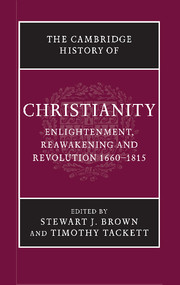Book contents
- Frontmatter
- Introduction
- PART I CHURCH, STATE, AND SOCIETY IN THE EUROPEAN WORLD, 1660–1780
- PART II CHRISTIAN LIFE IN THE EUROPEAN WORLD, 1660–1780
- 5 The Catholic clergy in Europe
- 6 The Protestant clergies in the European world
- 7 Reaching audiences: Sermons and oratory in Europe
- 8 Christian education
- 9 Christianity and gender
- 10 Popular religion
- 11 Jewish–Christian relations
- 12 Architecture and Christianity
- PART III MOVEMENTS AND CHALLENGES
- PART IV CHRISTIAN DEVELOPMENTS IN THE NON-EUROPEAN WORLD
- PART V REVOLUTION AND THE CHRISTIAN WORLD
- Chronology
- Bibliography
- Index
- References
10 - Popular religion
from PART II - CHRISTIAN LIFE IN THE EUROPEAN WORLD, 1660–1780
Published online by Cambridge University Press: 28 March 2008
- Frontmatter
- Introduction
- PART I CHURCH, STATE, AND SOCIETY IN THE EUROPEAN WORLD, 1660–1780
- PART II CHRISTIAN LIFE IN THE EUROPEAN WORLD, 1660–1780
- 5 The Catholic clergy in Europe
- 6 The Protestant clergies in the European world
- 7 Reaching audiences: Sermons and oratory in Europe
- 8 Christian education
- 9 Christianity and gender
- 10 Popular religion
- 11 Jewish–Christian relations
- 12 Architecture and Christianity
- PART III MOVEMENTS AND CHALLENGES
- PART IV CHRISTIAN DEVELOPMENTS IN THE NON-EUROPEAN WORLD
- PART V REVOLUTION AND THE CHRISTIAN WORLD
- Chronology
- Bibliography
- Index
- References
Summary
Approaches to popular religion
In historical discourse, the term ‘popular religion’ has long had widely differing meanings depending upon the social group, the place, the time, and even the religious context for which it is used. One of the leading contemporary historians of popular culture, Michel Vovelle – closely linked to the celebrated Annales school of French historiography – has usefully distinguished between four approaches to this subject taken by historians in the twentieth century. The first approach considers popular religion as a sort of ‘original’, primitive religiosity of humankind, which over the centuries repeatedly adapted itself to the current cultural context, but remained fundamentally the same. Popular religion in this view is pre-Christian and even anti-Christian. It continues quietly to live its own life independent from ecclesiastical rules, often as a kind of underground religion, undocumented by official society. The anthropologist Margaret Murray was one of the first to make use of this powerful image in her 1921 book The witch cult in Western Europe. A similar approach has recently been used by certain medieval historians, who postulate the existence throughout the Middle Ages of a substantial, semi-Christianized rural and urban population which continued to embrace older religious concepts and to interpret Christian dogma and liturgy in its own essentially pagan manner. The Protestant and Catholic Reformations were, in this view, massive efforts to eradicate the ‘pagan’ or ‘magical’ legacy of pre-medieval and medieval society.
- Type
- Chapter
- Information
- The Cambridge History of Christianity , pp. 185 - 207Publisher: Cambridge University PressPrint publication year: 2006
References
- 2
- Cited by



